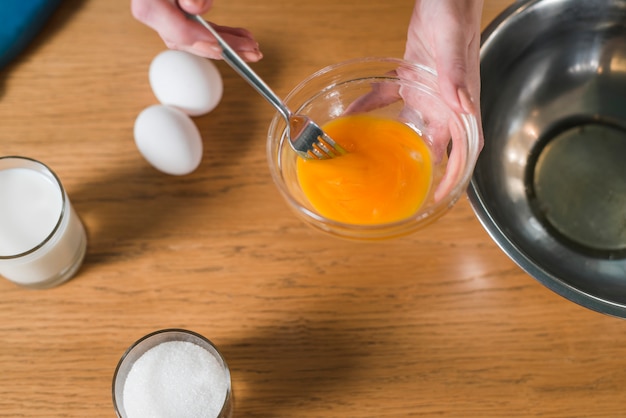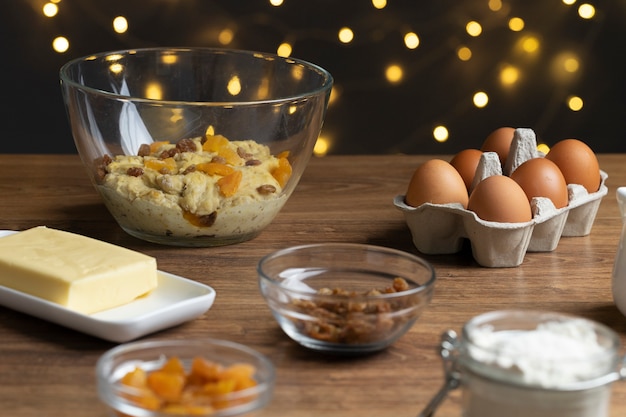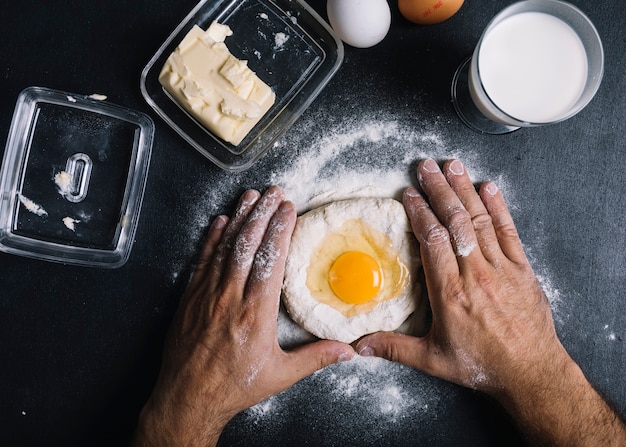Let's face it, we've all been there: craving a perfectly hard-boiled egg – that delightful combination of a firm white and a vibrant, perfectly cooked yolk. But then, disaster strikes. You end up with a rubbery white or a runny yolk that makes you want to throw in the towel. Don't fret, I've been there too! The quest for the perfect hard-boiled egg is a journey we all undertake. But trust me, with a little know-how and a bit of practice, you can crack open an egg that's a pure delight, every single time.
So grab a notepad, a cuppa (or a glass of something stronger, I won't judge), and let's embark on a journey to discover the secrets of the perfect hard-boiled egg. I'm going to share my tried-and-true methods, personal preferences, and maybe even a few little egg-cellent tips that I've picked up along the way. Ready? Let's get cracking!
(Part 1) Understanding the Basics: The Science of Cooking an Egg

The Egg's Anatomy: A Tiny Planet of Protein
First, we need to understand what we're working with. Think of an egg like a miniature planet, with different layers: the shell, the white (also known as the albumen), and the yolk. Each part has a unique protein structure that responds differently to heat. The white is primarily water, but it also contains proteins that solidify when heated, forming that firm, white texture we crave. The yolk, on the other hand, is a mix of fats and proteins. When heated, these components change from liquid to a thicker consistency, creating that creamy, delicious center we adore.
The Heat Factor: Finding the Perfect Temperature
The key to a perfect hard-boiled egg lies in mastering the heat. Too much heat, and you'll end up with a rubbery white that's tough to swallow. Too little heat, and your yolk will be runny, leaving you with a less-than-satisfying experience. It's all about finding that sweet spot where the white is firm but not tough, and the yolk is cooked through but still creamy and delicious. It's a delicate dance, but trust me, it's worth it.
(Part 2) Boiling Time: Finding the Sweet Spot

Now, let's talk about the crucial element: how long to boil those eggs. It's a bit like baking; you need to find that Goldilocks zone – not too long, not too short, just right. The boiling time determines the texture of the yolk.
A Handy Guide to Boiling Times: From Soft to Hard
Here's a general guideline, but remember, every stove and every batch of eggs is a bit different, so you might need to tweak the times slightly. It's all about experimentation, my friend.
| Texture | Boiling Time | Description |
|---|---|---|
| Soft Boiled | 3-4 minutes | A runny yolk surrounded by a tender white. Perfect for dipping soldiers or enjoying on toast. |
| Medium Boiled | 6-7 minutes | The yolk is set but still slightly runny, offering a creamy texture. A good option for salads or sandwiches. |
| Hard Boiled | 8-10 minutes | The yolk is firm and fully cooked, perfect for deviled eggs or other dishes requiring a solid texture. |
Personally, I'm a hard-boiled egg purist, so I usually go for the 10-minute mark. But if you prefer a creamier yolk, stick to the shorter boiling times. Experiment and discover your own perfect texture.
(Part 3) Methods: The Art of boiling eggs

There are several ways to boil eggs, but I've found that cold-water boiling is the most reliable method for consistent results. It's simple, straightforward, and helps prevent the eggs from cracking.
The Cold-Water Method: A Step-by-Step Guide
Here's the breakdown, step-by-step:
- Gather your eggs and place them gently into a pot. Avoid crowding the pot – give those eggs some breathing room.
- Pour in enough cold water to completely cover the eggs.
- Bring the water to a rolling boil. Make sure the water is bubbling vigorously.
- Once boiling, cover the pot and reduce the heat to a simmer. This helps ensure even cooking.
- Let the eggs simmer for the desired time according to the table above. Remember, you can always adjust the cooking time based on your preference.
- After cooking, drain the hot water and immediately place the eggs in a bowl of ice water. This stops the cooking process and makes the eggs easier to peel.
The Salt Debate: To Salt or Not to Salt?
You'll find a lot of advice about adding salt to the water. Some people swear it helps prevent cracking. I'm not convinced. In my experience, it doesn't make a huge difference. If you want to try it, go ahead, but it's not essential. What does matter is using fresh, room-temperature eggs. This helps prevent cracking.
(Part 4) Peeling Time: The Art of the Perfect Peel
Let's face it; peeling hard-boiled eggs can be a real pain. Especially when the shell stubbornly clings to the white, leaving you with a frustrating mess. But don't worry, I have a few tricks up my sleeve to make the peeling process a breeze.
The Rolling Trick: Cracking the Code
One of my favourite tricks is to roll the egg firmly on the counter or a cutting board, making sure to apply a bit of pressure. This helps to crack the shell and makes it easier to peel. It's a bit like giving the egg a little massage, helping the shell release from the white.
Adding Vinegar: A Little Acidic Assistance
Adding a tablespoon of vinegar to the boiling water can also help to loosen the shell. It works by breaking down the membrane that holds the shell to the white. It's a simple trick that can make a big difference.
The Tap Trick: A Gentle Tap for Easy Peeling
After the eggs are in the ice water, gently tap the blunt end of the egg on the counter. This creates a small crack that makes peeling much easier. Just a gentle tap, no need to go crazy.
(Part 5) Beyond Boiling: Other Egg-cellent Techniques
Boiling is the classic method, but there are other ways to cook hard-boiled eggs that you might want to try. Let's explore a few alternatives.
The instant pot: A Modern-Day Hero
The Instant Pot is a lifesaver for so many things, and cooking eggs is no exception. It creates perfectly cooked eggs every time, and it takes less time than boiling on the stovetop.
- Add 1 cup of water to the Instant Pot.
- Place a trivet inside. This will elevate the eggs above the water, ensuring they cook evenly.
- Arrange the eggs on the trivet.
- Close the lid and set the valve to seal.
- Cook on high pressure for 4 minutes.
- Let the pressure release naturally for 10 minutes. This allows the eggs to cool down gradually.
- Remove the eggs to an ice bath.
The Oven: A Surprising Alternative
Yes, you can bake hard-boiled eggs! Preheat your oven to 325 degrees Fahrenheit. Place the eggs in a baking dish and add enough water to cover the eggs. Bake for 30 minutes, then let the eggs cool in the water before transferring them to an ice bath. It might sound unusual, but the results are surprisingly good.
(Part 6) The Art of Using Hard-Boiled Eggs: From Breakfast to Dinner
So, you've got your perfect hard-boiled eggs. Now what? Well, the possibilities are endless! Here are a few ideas to get you started.
Breakfast: A Classic Start to the Day
- egg salad Sandwiches: A classic for a reason. Combine chopped hard-boiled eggs with mayonnaise, mustard, salt, pepper, and other seasonings of your choice, like celery or onion. Add a bit of crunch with chopped lettuce and a slice of tomato for a satisfying breakfast sandwich.
- Deviled Eggs: These are always a crowd-pleaser. Cut the eggs in half, scoop out the yolk, and mash it with mayonnaise, mustard, chopped gherkins, and other seasonings. Pipe or spoon the mixture back into the egg whites and sprinkle with paprika for a festive touch.
- Breakfast Bowls: Hard-boiled eggs add protein and texture to breakfast bowls, like oatmeal, yoghurt, or smoothies. Think of it as an extra protein boost to keep you full and energized throughout the morning.
Lunch and Dinner: Versatile and Delicious
- Salads: Hard-boiled eggs are a great way to add protein and flavour to salads. They work well with both green salads and salads with pasta, rice, or quinoa.
- Stir-Fries and Noodles: Chop hard-boiled eggs into small pieces and add them to stir-fries or noodle dishes for a boost of protein and flavour. They add a satisfying texture and a bit of savory richness to your meal.
- Sandwiches: Use hard-boiled eggs as a filling for sandwiches or wraps. Try them with other ingredients like avocado, tomato, and cheese for a flavorful and filling lunch.
- Soups: Hard-boiled eggs are a great way to add a hearty element to soups. They're especially good in cold soups like gazpacho, adding a creamy texture and a satisfying crunch.
Snacks: A Healthy and Filling Bite
Hard-boiled eggs are a great portable snack. Just peel them and enjoy them on their own, or pair them with other healthy snacks like fruit, nuts, or vegetables. It's a perfect way to keep hunger pangs at bay and provide a boost of protein and nutrients.
(Part 7) Storage: Keeping Your Eggs Fresh
Now that you've gone through all the effort of making the perfect hard-boiled eggs, you want to make sure they stay fresh and delicious.
- Refrigerate: Store hard-boiled eggs in the refrigerator for up to a week in an airtight container or zip-lock bag. This helps to prevent them from drying out or absorbing other smells in the refrigerator.
- Avoid Moisture: Make sure the eggs are completely dry before storing them. If they're too moist, they're more likely to spoil.
- Check for Spoilage: Check for signs of spoilage before eating, such as a green or black ring around the yolk, a foul smell, or a slimy texture. If you notice any of these signs, it's best to discard the egg.
(Part 8) FAQs: Your Hard-Boiled Egg Queries Answered
1. Why do my hard-boiled eggs have a green ring around the yolk?
The green ring is caused by a chemical reaction between the iron in the yolk and the sulfur in the white. It's harmless but can make the egg less appealing. This can happen if the eggs are boiled for too long or at too high a temperature. Try cooking them for a shorter time or lowering the temperature.
2. How can I tell if a hard-boiled egg is cooked through?
The best way is to cut the egg in half. If the yolk is firm and not runny, it's cooked through. If the yolk is still runny, it needs to be cooked for longer.
3. Can I reuse hard-boiled eggs that are cracked?
It's best not to reuse cracked hard-boiled eggs. The cracks can allow bacteria to enter the egg, which can cause spoilage. It's better to err on the side of caution and discard any cracked eggs.
4. What if my eggs are too rubbery?
This usually happens when the eggs are boiled for too long. To prevent this, try cooking them for a shorter time. If you already have rubbery eggs, you can try to soften them by adding them to a pot of simmering water for a few minutes. It might not completely solve the problem, but it can help to improve the texture.
5. What is the best way to peel hard-boiled eggs?
The best way to peel hard-boiled eggs is to use a combination of the rolling trick and the tap trick. Roll the egg firmly on a counter to crack the shell, then gently tap the blunt end of the egg on the counter to create a small crack. Peel the egg starting at the cracked end. For stubborn eggs, try peeling them under running cold water. It can help to loosen the shell.
And there you have it! A complete guide to making the perfect hard-boiled egg. Now go forth and crack open some egg-cellent creations. I'm sure you'll be a hard-boiled egg master in no time. Happy cooking, and enjoy those perfect eggs!
Everyone is watching

Corn on the Cob: The Ultimate Guide to Perfectly Cooked Ears
Healthy MealsAh, corn on the cob. Just the name evokes images of sunny days, barbecues, and that sweet, juicy flavour that ...

Perfect Pork Roast Oven Cooking Time: A Guide to Delicious Results
Healthy MealsThere's something truly satisfying about a perfectly roasted pork. The aroma alone is enough to make your mout...

Ham Cooking Time: How Long to Bake, Smoke, or Boil a Delicious Ham
Healthy MealsAh, ham. It's a classic, isn't it? A real crowd-pleaser, especially around holidays. And when done right, it'...

Scallops: The Ultimate Guide to Perfect Cooking
Healthy MealsAh, scallops. Those delicate, sweet, and utterly delicious morsels of the sea. They hold a special place in my...

Spaghetti Squash: The Ultimate Guide to Cooking and Serving
Healthy MealsRemember that time you saw spaghetti squash at the supermarket, looking all bumpy and strange, and thought, "W...
